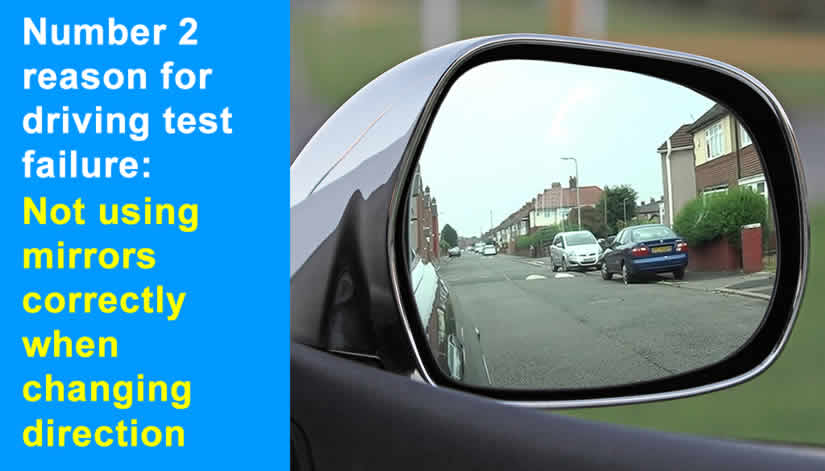The second most common reason for failing a driving test is due to the test candidate not using the mirrors correctly when changing direction. During a driving test, the examiner expects you to:
- Make effective use of all mirrors
- Check mirrors before making any change in speed or direction
- Check mirrors before signalling
- Make effective us of the ‘mirror, signal, manoeuvre’ driving routine
Checking your mirrors and knowing what’s around you is important for all drivers and it’s a safety procedure that’s particularly important before making any changes in direction or speed.
Examiners ensure that a test candidate’s mirror checks are of a high standard and any mistakes made will be counted under the ‘Mirrors – Change direction’ fault section of the driving test report sheet. To avoid becoming another driving test fails statistic for not using the mirrors correctly before changing direction, here’s the most common reasons that test candidates fail in this area.
Failing to use Mirrors Before Exiting a Roundabout
This situation fails many driving tests and it involves the test candidate turning right on a roundabout. You carry out the mirror, signal and manoeuvre routine before entering the right lane of the roundabout, but before moving over to the left lane to exit the roundabout, you must remember to check the rear and passenger-side mirrors (and sometimes the left-side blind spot too).
Failure to check the appropriate mirrors before moving over to the left lane will result in a serious fault, or if the examiner need to take control of the vehicle, a dangerous fault.
Failing to Check Mirrors After Exiting a Roundabout
On many large roundabouts, exit routes are often split into two lanes then merge into a single lane. A common test failure here involves the test candidate exiting the roundabout in the right lane and failing to check the mirrors, cutting across the path of a closely following vehicle that’s to the left-side of the car.
The exit lanes on busy roundabouts that merge lanes requires great observation. Regardless of whether you’re in the left or right lane, always check the appropriate mirrors and blind spot (if required), particularly just before the road merges.
Changing Lanes on a Roundabout into the Path of Another Vehicle
A lot of tests are failed each year at roundabouts and it’s often due to a lack of effective observation. In this situation, the test candidate tries to change lanes when another vehicle is directly alongside you. This would clearly result in a collision and requires the examiner to take control of the steering wheel. A dangerous fault will be marked on the driving test report sheet.
This situation often occurs when the test candidate realises that they are in the incorrect lane – often verbally pointed out by the examiner. The test candidate then panics by trying to get into the correct lane without carrying out appropriate observations.
If you do find yourself in this situation, remain calm and carry out the proper mirror and blind spot checks. If it’s not safe to change lanes, take an alternative route exit from the roundabout, or if the situation allows, continue around the roundabout to the intended exit. You wont fail a driving test for (safely) taking the wrong direction, but you will fail if you panic and do something dangerous.
Changing Lanes on a Dual Carriageway
This test failure involves the test candidate driving on a dual carriageway and before changing lanes, the driver checks the mirrors, but there’s a car approaching from behind. The test candidate continues to change lanes, but misjudges the speed of the approaching car, causing it to slow down.
If you want to change lanes but you’re unsure about a vehicle’s speed approaching from behind, wait a moment and take a second look. You’ll be able to judge the speed of the vehicle far better on the second mirror check. Additionally, use both the internal mirror and the door mirror when trying to assess a vehicle’s speed and distance.
Remember, the internal mirror is flat and reflects and accurate representation of what’s going on behind. But door mirrors are convex, or ‘curved’ and what you see in door mirrors look further away than they really are. For further information, see types of mirrors in a car explained. If you’re in doubt and are unsure whether it’s safe to change lanes, wait where you are until you’re sure.
